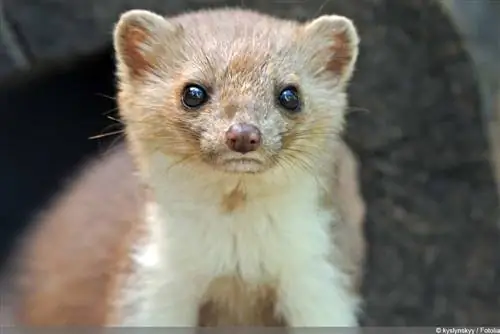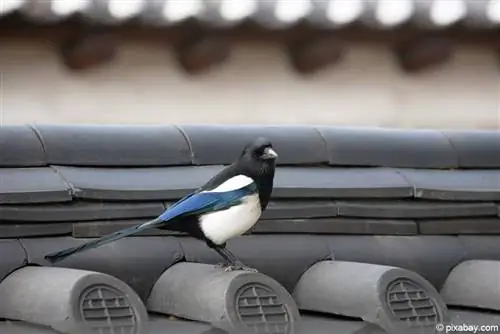- Author admin [email protected].
- Public 2023-12-17 03:39.
- Last modified 2025-01-24 12:45.
If a marten has arrived, you have to expect many unpleasant surprises. Gnawed pipes and brakes, feces and urine in the attic, dismembered prey in the garden - the list goes on and on. In order to limit the extent of the damage, you should act quickly. We reveal here what martens don't like or even hate.
Detecting martens
To effectively drive away martens, it is crucial to recognize the signs of an infestation. The nimble animals themselves are rarely caught “in the act”. Once they have moved in, however, there are typical indications of their presence. These include:
The Nest
The nest is made of soft materials such as feathers, strips of fabric and, for example, upholstery fillings. But hay and straw can also be found in it.
Markings
The animals mark their territory extensively with feces and urine. This can cause significant odor pollution, especially in summer or in warm rooms. The feces are visible to the naked eye, but urine stains can be made visible using appropriate UV lamps. This is important in order to be able to specifically treat and remove them later.
Food leftovers
The marten usually eats its prey near the nest, which is why the remains can also be found here. Bones, claws, teeth, feathers and fur may be noticeable. As with the markings, the residue can produce an intense smell. An intense smell of decay must be expected, especially with leftover meat.
Preferred habitats

In order to specifically deter and drive away the unwanted inhabitants, the martens' preferred habitats must be known in addition to their way of life. These include:
Quiet rooms in the house
Rarely used and quiet rooms in the house are among the martens' popular accommodations. Attics in particular, but also basements, storage rooms and garages are often used as shelter by these dog-like predators. The quieter and darker the rooms are, the more popular they are. An attic with lots of boxes and boxes that is rarely visited by people is therefore ideal for small animals.
Garden
Stacks of wood on the house wall, garden shed, tool shed - the garden also offers some potential hiding places and habitats for the ferrets' wild relatives. If the garden is not visited daily and is therefore generally quiet, the risk of it becoming a home for marten families increases.
Cars
The predators don't settle in cars permanently, but they still offer protection and warmth and are therefore popular with martens. This can be expensive or even dangerous for drivers, as marten damage to brakes and pipes is not uncommon. In order to drive martens out of storage and living spaces or the garden, these areas should be designed as habitats to deter the animals.
Controls and order
Since the small predators feel most comfortable when they are undisturbed by people and pets, regular checks can help detect an infestation as quickly as possible and drive the animals away. The following tips are simple but effective:
- check otherwise unused rooms at least once a week
- Turn on the light and ventilate the room
- illuminate dark corners and niches with a flashlight
- Organize storage rooms and other storage areas as well as possible so that the animals find fewer hiding places
It is also ideal if noises are generated during the checks as a deterrent.
Sounds

Since martens prefer quiet areas that are rarely frequented by people and pets, “noise” can be downright frightening. Simple measures are also available for this:
- Play music
- shred regularly in the garden, mow the lawn or let pets and children play
- play recorded animal sounds of cats or dogs
- install defense systems on the car that emit high-frequency noises either at regular intervals or through a motion detector
Brightness
As crepuscular or nocturnal animals, martens shy away from light. Since they particularly dislike bright and glaring light sources, these can be used wonderfully as a deterrent.
- turn on the lights regularly in otherwise unused rooms
- Use timers to keep the lights on in the evening
- Use motion detectors so that the light only comes on when the animals are active
- light up dark corners with a flashlight
In this way, the predators are repeatedly caught when they want to make themselves at home and are thus driven away. The use of light or lamps can also be wonderful for the garden and other outdoor areas. There is no need to put in a lot of effort for this. Simple lights with a motion detector can be installed almost anywhere and operated using batteries. This can, for example, protect the car from marten damage and the garden can be made unattractive for the animals.
Movements
Martens are shy and agile and can therefore be driven away comparatively quickly by movements, because they quickly suspect danger behind them. They also hate unrest. Again, simple changes are enough to take advantage of movements and drive the animals away.
Rearranging
When clearing out otherwise rarely used areas, the first traces of the animals are already noticeable. On the other hand, the area becomes less attractive for the animals. Of course, it doesn't really have to be rearranged; pushing and briefly lifting larger objects and walking around the room is usually enough.
Children and pets
Children and pets playing is an ideal deterrent both in the living room and in the garden. If you don't have children or pets, you can help out with a marten infestation by visiting.
Move car
If the car is rarely used and is parked outside, it can quickly become a victim of marten damage. It is better to at least turn on the engine and, if necessary, roll a few meters or, especially in the evening and morning, open and close the doors. These movements make the car less attractive to the animals.
Cleaning and tidying up
Indoor areas, simple cleaning and tidying up can help make the space a deterrent for animals. Vacuuming, using cleaning products with a lavender scent and avoiding confusing corners bring movement into the room. On the other hand, sounds and smells are also used to keep the dog-like predators away.
Smells and fragrance

Various smells but also special scents are perceived as deterrent by martens and can therefore be used specifically to drive the animals away. These products are suitable for both outdoor and indoor use and for protecting the car:
Cats
Used cat litter, brushed fur and feces can be used. The cats' scent marks act as markers for predators and ensure that martens run away.
Dogs
Just like with cats, dog scent tags can also have a deterrent effect. If you don't keep dogs yourself, you can, for example, invite dog owners or ask owner friends for "scent samples". Again, brushed fur, blankets and also feces are good ways to deter predators.
Bears
This measure may seem unusual, but experience has shown that it is ideal for repelling martens. Bear urine and fur can be used to deter the predators. Bear urine can be purchased commercially as the smell is also used to scare away other wild animals. Untreated fur may be available at the zoo if necessary. It's worth asking here.
Herbs
The scent of herbs such as lavender and citronella is said to keep the small predators away. The advantage of this method is that the scent or smell is quite pleasant for human noses. In addition, the lavender etc. can be used freshly planted in the garden, on the windowsill or dried and scattered around the house or on the car.
Special sprays
Special deterrent sprays also use fragrances and mixtures thereof to act as a deterrent. They work immediately and with little effort and can be used both indoors and outdoors.
Eliminate food sources
In addition to quiet, dark places, nearby food sources are also attractive. This includes leftover food in the garbage but also bird nests. The following tips can help make them inaccessible:
- Protect trees against cats and martens, for example with a spiked ring on the trunk
- Hang bird baths, feeders and nesting boxes at a safe height and protect them from climbing animals
- Make trash cans burglar-proof
Water
Sprinkler systems with motion detectors can be particularly suitable for the garden. These can also be used on paths and around the car, for example, and only come on when an animal passes through the motion detector sensor. The advantage of this is that the plants are also watered at the same time. The disadvantage is that potentially useful animals can also be driven away and a lot of water may be wasted - at least initially. However, water is definitely suitable for selective use, as the predators hate the wet.
Tips for the car

So that the car does not suffer damage from martens, it should be well protected. One possibility is to (subsequently) install a protection system that produces deterrent sounds for marten ears. Another option is a grille or a special protective mat under the hood. Since the animals do not like to move on grids and metal surfaces, the mats or grids prevent them from entering the engine compartment.






